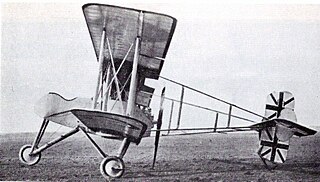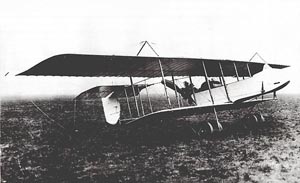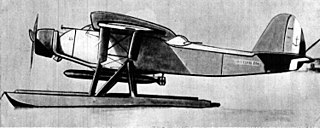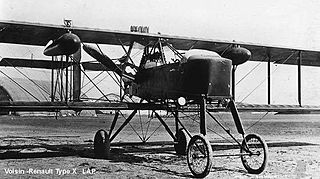
The Dewoitine D.500 was an all-metal, open-cockpit, fixed-undercarriage monoplane fighter aircraft designed and produced by French aircraft manufacturer Dewoitine.

The Breguet XIV or Breguet 14 was a French biplane bomber and reconnaissance aircraft of World War I. It was built in very large numbers and production continued for many years after the end of the war.

The PZL.23 Karaś was a Polish light bomber and reconnaissance aircraft designed in the mid-1930s by PZL in Warsaw.

The SPAD S.XIII is a French biplane fighter aircraft of the First World War, developed by Société Pour L'Aviation et ses Dérivés (SPAD) from the earlier and highly successful SPAD S.VII.

The Bloch MB.210 and MB.211 were the successors of the French Bloch MB.200 bomber developed by Société des Avions Marcel Bloch in the 1930s and differed primarily in being low wing monoplanes rather than high wing monoplanes.

Between 1911 and 1914, the Royal Aircraft Factory used the F.E.2 designation for three quite different aircraft that shared only a common "Farman" pusher biplane layout.

The Voisin III was a French World War I two-seat pusher biplane multi-purpose aircraft developed by Voisin in 1914 as a more powerful version of the 1912 Voisin L. It is notable for being the aircraft used for the first successful shooting down of an enemy aircraft on October 5, 1914, and to have been used to equip the first dedicated bomber units, in September 1914.

The Martinsyde G.100 "Elephant" and the G.102 were British fighter bomber aircraft of the First World War built by Martinsyde. The type gained the name "Elephant" from its relatively large size and lack of manoeuvrability. The G.102 differed from the G.100 only in having a more powerful engine.

The Caudron R.4 was a French World War I twin-engine biplane reconnaissance/artillery cooperation aircraft and the progenitor of a series of successful aircraft that filled a variety of roles with the French Aéronautique Militaire.

The Bristol T.B.8, or Bristol-Coanda T.B.8 was an early British biplane built by the Bristol Aeroplane Company and designed by the Romanian Henri Coandă. Fifty four Bristol T.B.8s were built, being mainly used as a trainer. A small number of Bristol T.B.8s were briefly used as bombers at the start of the World War I by the Royal Naval Air Service.

The Bréguet Bre.4, also known variously as the Type IV and BUM, was a French biplane bomber of World War I. A fighter version of it was also produced as the BUC and BLC; some of these saw service with the British Royal Navy, which called them 'the Bréguet de Chasse.

The Caudron R.11, was a French three-seat twin-engine long range escort fighter biplane developed and produced by Caudron during the First World War.

The Farman F.50 was a French twin-engined night bomber designed and built by Farman as a replacement for the single-engined Voisin pusher biplanes in service with the French Air Force.

The Farman HF.20 and its derivatives were a family of reconnaissance aircraft produced in France shortly before and during the First World War. It was a refined version of the Farman MF.11 "Shorthorn" that did away with the type's distinctive landing skids, and incorporated design features from Henri Farman's designs. It entered service with the French, Belgian and Serbian armies in 1913, and with the British RFC and RNAS shortly after the outbreak of war. The type was also licence-built in the UK by Airco and Grahame-White.

The Levasseur PL.2 was a French biplane torpedo bomber designed by Pierre Levasseur for the French Navy.

The Latécoère 290 was a torpedo bomber floatplane produced in France during the 1930s. Designed by Latécoère in response to an Aéronavale specification for such an aircraft, the 290 was based on its successful Laté 28.3 mail plane. It was a conventional high-wing, strut-braced monoplane that carried a single torpedo externally under the fuselage.

The Levasseur PL.10 was a carrier-based reconnaissance aircraft developed in France in the late 1920s. It was a conventional, single-bay biplane along similar lines to Levasseur's contemporary designs for the French navy, including a watertight, boat-shaped fuselage, small underwing floats, and undercarriage that could be jettisoned in flight in order to improve the chances of a successful ditching.

The Potez 35 was a twin engine bomber aircraft, designed and built in France in the late 1920s. Only one was completed.

The Voisin VIII was a French two-seat biplane pusher which was built in two versions, one fitted with a 37mm Hotchkiss cannon, and the other as a conventional bomber. Problems with the Peugeot 8Aa engine led to a short operational career with front line units before being superseded by the Voisin X, which aside from the installation of a new Renault engine, was nearly identical to the VIII.

The Voisin X was a French two-seat pusher biplane which was built in two versions, one fitted with a 37 mm (1.46 in) Hotchkiss cannon, and the other as a conventional night bomber. Problems with the Peugeot engine in the previous Voisin VIII led to the installation of a new Renault engine of greater power and reliability, but the new aircraft was otherwise nearly identical to the VIII. Despite its obsolescence, it would make up the bulk of front line night bomber escadrilles until the end of the war.




















